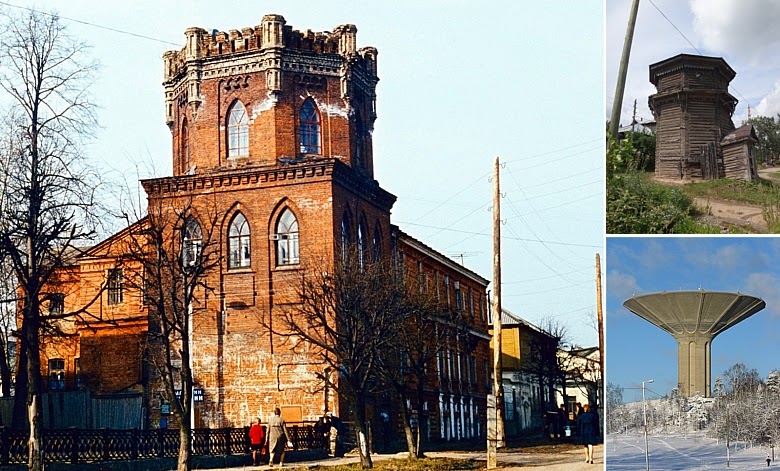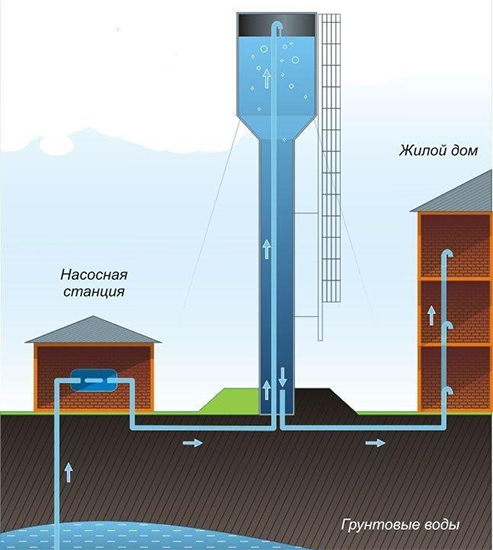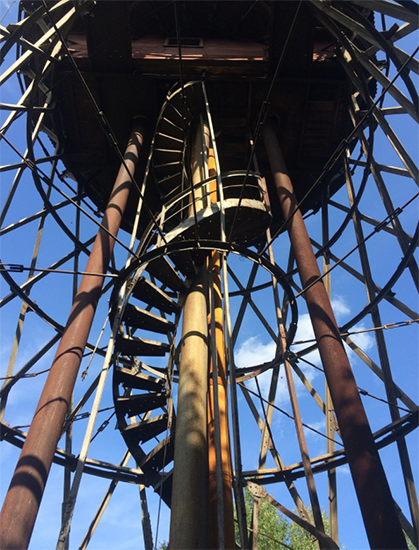There are a lot of such structures throughout Russia. Water towers can also be found in large cities - Moscow, Yekaterinburg, St. Petersburg, and in villages. Many of them still fulfill their intended purpose. And this post is about how they work, what types of towers are there, and a little more about the fate of Slobodskoy.

The text below is an editorial revision of one of the issues of the talk show "Let us disassemble into atoms", which was held in August by the Kirov Nuclear Energy Information Center with the support of our Kirov Boiling Point at VyatSU.

It was attended by Anatoly Kurbatov - the new owner of the Slobodskaya Tower, candidate of technical sciences Denis Suvorov, candidate of historical sciences Anton Kasanov and design engineer Alexander Anushchenko, who spoke about the engineering aspects and architectural features of water towers. The full recording of the talk show can be found in the event description on the Leader-ID.
The story of how Anatoly Kurbatov bought this tower is also interesting, but in order not to clutter up the text, I will put it under the spoiler.
History of the Slobodskaya Tower
35 , , — . , , , « » . . , .

:
2015 . — , 1911 , 50 . — 941 . , , .
, . , — , !

, , — . . — , (« »). . , .
, , . , .

:
2015 . — , 1911 , 50 . — 941 . , , .
, . , — , !

, , — . . — , (« »). . , .
, , . , .
. — 625 .
Why do you need water towers
The idea of water towers is so simple and ingenious that to this day, in various parts of the planet, you can find modern structures that perform the same functions. At the beginning of the 20th century, pumps capable of pumping water through pipes already existed and were even partially used in public utilities. But the invention of hydraulic pumps powered by electricity was a real engineering achievement of the time. After all, after their installation, residents did not need to turn the handle at the well - the water itself rose through the pipes and poured into the buckets. However, for the construction of a powerful city water supply, the productivity of such pumps was not enough. Why not build a system for pumping water with a more powerful pump? It was theoretically possible, but economically impractical.
Another problem that prompted the development of water tower technology was that people use water extremely unevenly. In the early morning, when we just wake up, and also at night, when we sleep, water is not particularly needed. Perhaps there are one or two local residents who use the water supply for some reason at this time, but this is an exception.

At about 6-8 o'clock in the morning, people wake up, wash, eat breakfast, and the load on the water supply system increases. Well, in the afternoon, enterprises start working, irrigation systems are turned on, and water consumption increases several times. And at this moment, when using a low-power pump, the transfer of water will practically stop, since it simply will not have time to pump water into the system.
The inexpediency of using powerful pumps was also in the fact that then there were no "smart" controllers that would monitor the power regulation. If you look at the design of the pumping systems used in most of the older water towers, you can see that the older pumps have only two modes of operation - "on" and "off". This means that a powerful pump would be very wasteful of resources.

The largest horizontal split crankcase pump manufactured by the Indian company Kirloskar Brothers Limited (KBL). Able to create a flow of 7000 liters per second at a pressure of 27.5 meters
As a result, water towers began to be quickly erected in a variety of places.

Water tower in Zaraysk, 1916

Water tower by architect Geppener in Moscow, 1901
What's inside the water tower
At the top of the tower is a large water tank. The level to which this tank is installed must be higher than the tallest building to which water will be supplied. The difference in height is very important because the entire principle of a water tower is based on the pressure that the liquid column creates.

Pipes lead to the tank from the pumping station, where a low-power pump is usually used, gradually filling the reserve tank.

The functionality of the water towers is simple. However, if we look at the architecture of such buildings in Europe, especially at the beginning of the 20th century, we will see that the appearance of many of these buildings often resembles medieval castles.

More modern towers can have futuristic designs, like Helsinki's Roihuvuori, one of the largest water towers in the world.

Roihuvuori water tower, 1977. Currently not in operation
This tower was built in the form of a mushroom, its maximum diameter is 66.7 m and a height of 52 m, and the volume of the tank is 12 600 m 3 .
In the USA, where business is known for its pragmatism, even old water structures have a strict look - a reservoir with supports. Nothing superfluous, no more expensive "beauties", if only the design fulfills its purpose.

Water tower on the roof of the former Ford facility in Omaha, Nebraska
The so-called Rozhnovsky Towers were the most popular in Russia. They do not shine with graceful design, but are extremely reliable, especially given our harsh climatic conditions.
The Rozhnovsky Tower is designed in such a way that the water in it does not freeze even at –30 degrees Celsius. In this case, correct operation is very important: at such a low temperature, water intake should occur at a rate of two tanks per day. If the pressure decreases, the water will indeed turn into ice.

Rozhnovsky's tower and its internal structure
During the construction of water towers in old Russia, combined materials were often used - brick and wood. Brick, as a more durable material, was used to build the barrel of the water tower, and the upper floor was made of wood. Wood was lighter, and its use was also conditioned by the presence of cold winters in Russia. Modern water towers, like the construction of Rozhnovsky, are made exclusively of metal.
Conventional water towers were built for six months, but Rozhnovsky's structure was installed several times faster. The towers were built along the railway tracks because they were originally designed to quickly fill steam locomotives with water. According to the standards, the lifespan of such a tower is 30 years, but due to its robust design, the actual lifespan is much longer.
The main components of Rozhnovsky's water tower are not much different from other structures of water towers: a water tank, a water-pressure metal support, a tank lid with an inspection hatch. The thickness of the walls of the barrel and dome of such water-pressure structures is the same - about 5 mm. The design of the Rozhnovsky tower provided for the installation of two tanks at once, located in relation to each other at different heights. The need to use two tanks could arise if it was required to provide several water-pressure networks with different water pressure in each. The maximum tower height rarely exceeds 30 meters.

Installation of a modern water tower
On the inner wall of the tank, ice holder brackets are welded, as well as brackets for lowering service personnel. To climb the tower, use an external staircase with a safety fence.
Once every three to four years, it is necessary to carry out routine maintenance - to identify and repair cracks and leaks, remove rust, disinfect the tank, paint, replace the fastening metal ring.

Shukhovskaya water tower in Polybino, Lipetsk region, 1896 The
legendary Shukhov tower stands out from all structures. Vladimir Shukhov invented the world's first hyperboloid structures and came up with a method for erecting mesh shells. Thanks to the new shape and technology of fastening, such metal towers had high strength with less weight. Today such structures are rarely remembered, nevertheless, in different cities you can still find water towers in the recognizable "Shukhov" style.

Staircase on the "Shukhovskaya" tower
Pros and cons
The water towers were a very good solution. They have a lot of advantages and are still used in those areas where it is necessary to ensure the transfer of water through pipes with a minimum investment.
Even a schoolboy can calculate the pressure in a water tower. First, you should determine the height of the rise of water using the formula h = n * h e , where n is the number of floors in the building, and h e is the height of the floor. We recall Pascal's formula for determining the pressure at the level of the Earth:
P = ρ * g * H,
where ρ is the density of water, g is the acceleration of gravity, and H is the height of the water tower. This makes it easy to calculate the pressure in a water tower on any floor of a building.
In modern buildings, the water pressure usually does not exceed 6–8 atmospheres (according to SNiP 2.04.01-85, from 0.3 to 6 atm for cold and from 0.3 to 4.5 atm for hot). For buildings above 40 meters, pressure regulators are additionally used (and water can be supplied from top to bottom), and for high-rise, entire technical floors with pumping stations are being constructed.
The towers also have drawbacks, although they are few. The main disadvantage is binding to height. As the experience of using water towers shows, in settlements, sooner or later, ever higher buildings are being erected, for which the pressure created by the height of the pipes in the tower is no longer enough. Here, either a new tower needs to be built, or the design of the water supply system must be completely revised. Since both solutions are too expensive, in such cases, in high-rise buildings, the tank is usually installed directly on the roof.

Tower in Novosibirsk, 1938.
Water towers are very easy to "adapt" to the conditions of modern times. Old buildings are being renovated and turned into offices or shops. And even better - to museums, because many of these structures have a rich history.
Ok, I bought it. Now what to do with the "water pump"?
Kurbatov admitted that at first it was difficult for him to accept the very fact that "all this" is now his responsibility. From now on, he needs to decide how the building will look and what will be in it.
Surprisingly, thirty years ago, while the tower was at the disposal of JSC "Kirovskie Kommunalnye Sistemy", it performed its main function. Later, it was no longer used for its intended purpose and it changed hands many times. Once there was a shop called "Hunter and Fisherman", and at the beginning of the 2000s there was a representative office of a regional television company. We are not talking about using the water pumping station for its intended purpose - there is no need for this, and it is technically difficult to do it. This means that we need to look for new options for using the structure.
Kurbatov plans to divide the building into two parts. On the lower floors, open a museum, and the upper, fourth floor, from where a stunning view of the city opens, will be used as a hotel with rooms for lovers of romance.
As for the subject matter of the museum exposition, there is still no certainty. On the one hand, the museum can be dedicated to Ivan Charushin, the main architect of the Vyatka province. On the other hand, you can make a modern museum of water structures with interactive three-dimensional presentations illustrating the architecture of water towers in different places on the planet.
The final decision regarding the future of the building will be made when the facade is restored and the interior rooms are restored. All the same, the choice of the option is secondary, and the main thing is to save the building, stop the destruction and return it to its former charm. Unfortunately, there are many examples when, after careless repairs and "restoration" of historically valuable buildings transferred by the authorities to private ownership, not a trace remained of the original appearance. But Anatoly decided that he would do his best to save the tower.
A technical survey has already been carried out, an estimate has been drawn up and the scope of work has been determined. According to preliminary estimates, the restoration of the building will require about 1.8 million rubles.
Some of the tasks were taken over by volunteers. First of all, it was necessary to remove the overgrowth, including the one that covers the upper floor of the building. These accidentally sprouted plants are very dangerous: their root system slowly but steadily destroys the building. Another big concern is to clear the house from mountains of garbage that has accumulated there for many years, and take it out.
All problems and questions: “how best to organize the work”, “what pitfalls you can face” and others - you have to solve on your own, because there is simply no one to ask. If you look at the whole of Russia, it turns out that we do not have much experience in restoring objects of this kind. You can only rely on your own strength. However, there is hope for a grant - both presidential and private or state-owned companies, which will significantly reduce their own costs.

Anatoly Kurbatov on one of the floors of the tower. As you can see, the stove heating is still in service.
For the restoration of the external facade of the water tower, Anatoly decided to use the potential of the movement to restore the urban historical environment Tom Sawyer Fest . The persistence of the members of this group finally began to bear fruit: today the team of volunteers has more or less permanent sponsors, including such companies as MTS, Stanley, Black & Decker, Leroy Merlin.
Another slightly forgotten, but very correct tradition is Saturday clean-ups. To date, the new owner has already carried out several such events, thanks to which the business has moved off the ground. By the way, a positive example is always contagious. Even the chief architect of Slobodskoy and the head of the city improvement department offered their help, many people came from Kirov.
Instead of totals
Modern pumping systems have practically supplanted water-pressure structures. Electronics and other equipment that adapts the pump to the conditions are becoming "smarter" and constantly cheaper. Probably, over time, people will completely abandon the idea of using water-pressure structures and another problem will arise: what to do with the structure. Perhaps exotic hostels with panoramic views from the top floor, new museum exhibitions will appear. There is another tendency: such structures are bought out and converted into residential buildings. You can google a lot of original stories on the web, but they probably deserve a separate story.